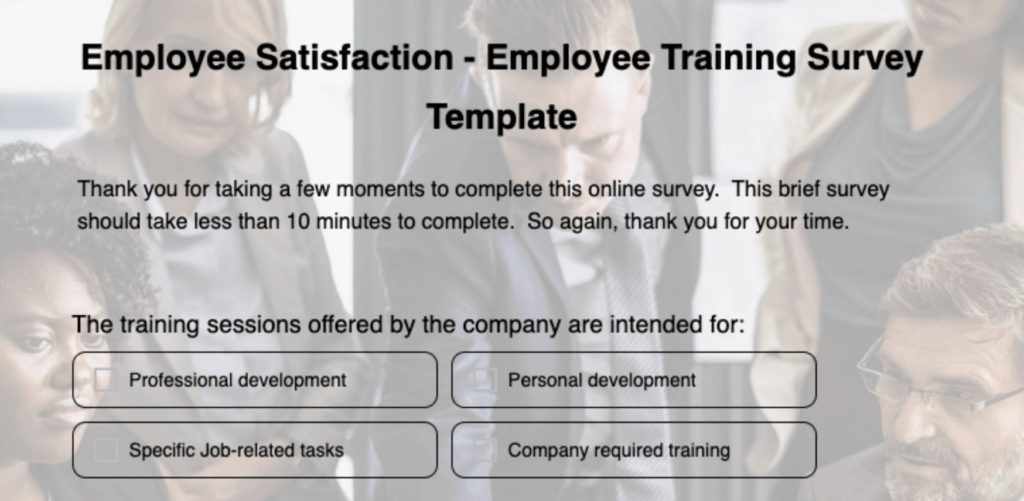
Want to make sure your employee training really boosts skills, productivity, and keeps your team sticking around longer? The trick is figuring out if your training is hitting the mark.
The best way to go about that is to dive into training surveys. By asking the right questions, you can get a real feel for how your employees experienced the training or whether it had any impact at all.
However, the phrase “right questions” is your key here. Without them, no matter how good a tool you use, the survey is going to fall flat.
In this blog, I’m going to walk you through some top-notch training survey questions you can toss into your next survey to ensure your training efforts truly resonate and deliver results.
Here’s a short video on the process of survey creation to get you started:
Watch: How to Create a Survey Using ProProfs Survey Maker
What Are Training Surveys?
A training survey is a feedback and evaluation method that helps you obtain employee perspectives about a training session, whether good or bad.
Think of it like a bridge connecting what happens during a training session and the real-world impact it has on participants – from the content to how it was delivered and how confident they feel applying what they learned to their daily tasks.

Training survey questions also help you understand the employees’ viewpoints on a training program, letting you make necessary changes and enhance its effectiveness.
Basically, employees are asked to fill out a questionnaire to gather qualitative and quantitative data. A questionnaire can contain closed-ended questions, open-ended questions, Likert scale questions, rating scale questions, or multiple-choice questions, depending on what an organization wants to measure.
This data is then analyzed to improve the framework and process of a training program.
Precisely put, these surveys help you:
- See things from an employee’s perspective
- Gather employee feedback by asking them training survey questions
- Outline training outcomes
- Evaluate training effectiveness
- Measure the training’s return on investment
- Determine employee satisfaction with the training program
- Make improvements in the training and plan efficiently for future courses
Training Survey Question Examples for Your Survey
Conducting a training survey can help you gather valuable information from training participants. You get a front-row seat to your respondents’ opinions, expectations, and experiences, and this information can be used to improve the quality and efficacy of your training.
Training questions can be asked before or after a training program to measure training effectiveness and employee satisfaction levels.
Let’s discuss some sample training survey questions for different scenarios:
Pre-training Evaluation Questions
1. What is your current level of knowledge about the training topic?
- No knowledge
- Basic understanding
- Moderate understanding
- Advanced understanding
2. What are your specific learning goals for this training?
(Open-ended response)
3. How do you prefer to learn new information?
- Reading materials
- Interactive workshops
- Video tutorials
- Hands-on practice
4. What challenges do you face that you hope this training will address?
(Open-ended response)
5. How will you apply the skills learned from this training in your role?
(Open-ended response)
6. Rate your interest level in the training topic.
- Not interested
- Somewhat interested
- Very interested
- Extremely interested
7. How do you feel about your current skills related to the training topic?
- Not confident
- Somewhat confident
- Confident
- Very confident
8. What format of training do you find most engaging?
- Lectures
- Group discussions
- Case studies
- Simulations
9. How much time can you dedicate to this training each week?
- Less than 1 hour
- 1-2 hours
- 3-5 hours
- More than 5 hours
10. What tools or resources do you hope to gain from this training?
(Open-ended response)
Post-training Evaluation Questions
1. How would you rate the overall quality of the training?
- Poor
- Fair
- Good
- Excellent
2. Did the training meet your learning objectives?
- Yes, completely
- Yes, but not all of them
- Somewhat
- No, not at all
3. How effectively were the concepts presented?
- Very ineffective
- Somewhat ineffective
- Somewhat effective
- Very effective
4. How confident do you feel applying the knowledge gained from this training?
- Not confident
- Somewhat confident
- Confident
- Very confident
5. What aspect of the training did you find most valuable?
(Open-ended response)
6. Was the training length appropriate for the content covered?
- Much too short
- Somewhat too short
- Just right
- Somewhat too long
- Much too long
7. How likely are you to recommend this training to others?
- Very unlikely
- Unlikely
- Likely
- Very likely
8. What improvements would you suggest for this training?
Open-ended response
9. How relevant was the training content to your job?
- Not relevant
- Somewhat relevant
- Relevant
- Very relevant
10. After this training, what additional support or resources do you need to apply what you learned effectively?
(Open-ended response)
What Are the Benefits of Training Surveys
Training surveys are invaluable tools that help you tap into the effectiveness of your training sessions. Here’s how they can make a real difference for you and your organization:
- Immediate Feedback: Imagine knowing right away what’s working and what’s not in your training sessions. Training surveys give you this direct insight, allowing you to tweak and improve as needed.
- Spot Knowledge Gaps: Ever feel like some gaps remain despite thorough training? Surveys can highlight these areas, helping you focus your efforts where they are most needed to enhance learning.
- Boost Engagement: Are your sessions capturing everyone’s attention? Find out through surveys! Understanding how engaged your participants are helps you adjust your methods to keep everyone involved and interested.
- Measure Impact: It’s crucial to show that your training efforts are worth it. Pre- and post-training assessments let you measure the actual skills and knowledge your team gains, proving the value of your programs.
- Reinforce Learning: Reflecting on new knowledge through a survey can reinforce what participants have learned, turning training into tangible skills.
- Tailor Training to Needs: Your teams have unique needs and preferences. Surveys uncover these differences, allowing you to customize training to suit various groups, making learning more relevant and effective.
- Maximize ROI: Continuously refining your training approach based on survey feedback ensures that you’re investing wisely in training, helping you get the most from your budget.
- Foster Continuous Improvement: When you regularly use surveys, you’re building a culture that values growth and feedback. This environment can lead to greater efficiency and satisfaction at work.
- Ensure Accountability: Surveys provide accountability for both trainers and trainees. Trainers get direct feedback on their performance, and trainees are reminded to engage actively and apply what they learn.
- Show Your Commitment to Development: Using training surveys demonstrates your commitment to your team’s growth. This commitment can boost morale, increase job satisfaction, and reduce turnover.
By integrating training surveys into your development strategy, you’re not just teaching; you’re engaging in a dialogue with your team to ensure that every training session is as beneficial as possible.
This approach aligns your training goals with your business objectives, creating a pathway to success that everyone can follow.
What Are the 3 Stages of Training Evaluation Surveys?
Training evaluation surveys are divided into three distinct stages. Methodically assessing them allows you to continuously refine your approach, making each session more targeted and effective.
Let’s explore each stage to understand how they contribute to enhancing your training initiatives from start to finish.
1. Pre-Training Evaluation
Before the training session kicks off, it’s important to establish a baseline. This initial phase helps you tailor the content to the participants’ needs and expectations.
Here’s what it helps you do:
- Identify Prior Knowledge: Understand the existing skills within the group to adjust the training content appropriately.
- Understand Expectations: Determine what participants are aiming to gain, aligning the training objectives with their goals.
- Establish Benchmarks: Set clear benchmarks that will later aid in measuring the progress made through the training.
2. Mid-Training Evaluation
This is essentially a check-in to adjust the course while it’s underway, ensuring the training is effective and engaging for everyone involved.
What this stage covers:
- Monitor Engagement: Keep track of engagement levels and make adjustments to maintain or increase interest.
- Adjust Content Delivery: If certain elements aren’t resonating, this is the time to tweak them to better meet the group’s needs.
- Evaluate Learning Progress: Use interactive elements like quizzes to gauge understanding and retention up to this point.
3. Post-Training Evaluation
After the session concludes, this final evaluation helps you understand the effectiveness of the entire training and its applicability.
Key insights you’ll gather:
- Measure Learning Outcomes: Assess whether the training met its goals and how much participants have learned.
- Assess Application of Skills: Explore how participants plan to apply what they’ve learned in their everyday roles.
- Gather Overall Feedback: Solicit feedback on all aspects of the training to refine future sessions. This feedback is invaluable for continuous improvement.
FREE. All Features. FOREVER!
Try our Forever FREE account with all premium features!
How to Use Surveys to Boost Training Effectiveness
You have successfully created a training evaluation survey – what now? How do you ensure that it is impactful and resonates with your recipients so that you can uncover the data you intend to?
Let’s see.
Set Clear Goals for Your Surveys
First up, know what you want to achieve with your surveys. Are you looking to understand the baseline knowledge of your participants before they start? Or perhaps you want to gauge how well the training was received?
Setting specific goals for your surveys helps you craft focused and relevant questions, ensuring that you gather useful data.
Customize Content with Pre-Training Surveys
Before the training wheels even start turning, a pre-training survey can give you a sneak peek into what your participants know and expect. This is your chance to tailor the training content to fit the actual needs of your audience.
Ask about their current challenges, what skills they’re eager to improve, and how they best learn. This way, you can adjust your material so it’s not just informative, but also engaging and on point.
Adjust on the Fly with Mid-Training Surveys
Mid-training surveys act like a quick pulse check. They’re great for getting a sense of whether your message is getting through or if you need to tweak your approach. These can be simple, quick questions like, “Is the pace okay for everyone?” or “What topics would you like to explore more deeply?”
This real-time feedback is invaluable for making adjustments while the training is still in session – it ensures that everyone stays engaged and absorbs the material effectively.
Assess the Impact with Post-Training Surveys
Once the dust has settled, a post-training survey can help you measure the success of your session. This is where you find out if the participants found the training valuable if they feel confident applying what they learned, and how relevant they found the content.
This feedback not only measures the effectiveness of the training but also highlights areas where you can improve future sessions.
Dive Deep into Data Analysis
Collecting employee feedback is great, but analyzing this data to uncover insights is where the real magic happens. Look for trends in the responses that could indicate broader issues or successes within your training program. This analysis helps you refine your approach, ensuring that your future training sessions are even more successful.
Choose the Right Tools
Having a robust survey tool, like ProProfs Survey Maker, can make a big difference in keeping things running smoothly. These tools help you create survey, distribute survey, and analyze survey surveys efficiently, saving you time and providing you with easy-to-understand data that can inform your training decisions.
What Should You Ask? Example Questions to Include In Your Next Training Survey
Let’s take a look at some example questions to add to your training evaluation survey:
- Did the training meet your expectations?
- Was your trainer supportive and engaging?
- Was the included material engaging?
- Was the training platform easy to use and understand?
- Was the training material relevant to your role and/or position?
- Was there any part of the training that surprised you?
- What are your desired goals from completing this training?
- Did the time required to complete the training align with your expectations?
- If you could change one thing about the training, what would it be?
- Which topics would you like to learn more about?
- Would you be willing to offer thirty minutes of your time to help shape future training experiences?
How to Improve Survey Response Rates: 5 Quick Tips
Boosting survey response rates can significantly enhance the quality and reliability of the data you collect. Here are five quick tips to help you achieve better engagement and higher response rates for your surveys:
Keep It Short and Sweet
People are more likely to complete your survey if it doesn’t take up too much of their time. Aim to keep your surveys short and to the point—typically no longer than 5-10 minutes.
Pro Tip: Clearly communicate how long the survey will take at the outset, so participants know what to expect.
Craft Clear and Concise Questions
Ensure that each question is straightforward and avoids ambiguity. Use simple language and avoid jargon that might confuse respondents. Clear questions not only make it easier for participants to answer but also increase the accuracy of your responses.
Offer Incentives
A little motivation can go a long way. Consider offering incentives for completing your survey, such as a discount, entry into a giveaway, or access to exclusive content. Ensure the incentive is relevant and meaningful to your audience to maximize participation.
Optimize for Mobile
With many users accessing content via their smartphones, it’s crucial that your survey is mobile-friendly. This means ensuring the survey loads quickly on mobile devices, is easy to navigate, and does not require excessive zooming or scrolling.
Send Reminders
Life gets busy, and even interested respondents might forget to complete your survey. Sending a polite reminder a few days after the initial invitation can significantly boost response rates. Make sure your reminder email is courteous and concise and includes a direct link to the survey.
Obtain Valuable Employee Feedback With a Robust Training Survey
We hope the sample survey questions we’ve shared help you evaluate your training sessions effectively. Remember, conducting a training survey is not only a cost-effective way to gather feedback but also critical to determining the success of your training initiatives.
A well-crafted survey is as crucial as the training itself; it provides the insights needed to refine and enhance your programs. With ProProfs Survey Maker, you can easily design and implement training surveys that collect comprehensive employee feedback, ensuring your training efforts meet their goals and deliver impactful results.
FREE. All Features. FOREVER!
Try our Forever FREE account with all premium features!
Learn More about Training Survey Questions
Why should you run a training survey?
Running a training survey allows you to figure out what in your training is working and what isn’t, helping you optimize future training sessions and enhance learning outcomes.
What to ask in your training survey?
In your training survey, it’s best to include questions that assess participant satisfaction, understanding of the material presented, and the applicability of the skills learned. Ask about the pace and structure of the session, the clarity of content, and the effectiveness of the trainer. You can also include questions that probe how participants plan to apply what they’ve learned in their professional roles.
 Tips
Tips
We’d love to hear your tips & suggestions on this article!
FREE. All Features. FOREVER!
Try our Forever FREE account with all premium features!


 We'd love your feedback!
We'd love your feedback! Thanks for your feedback!
Thanks for your feedback!







